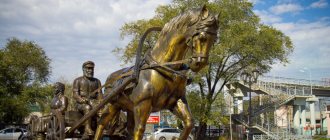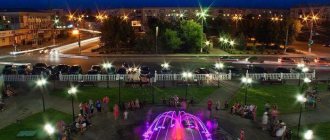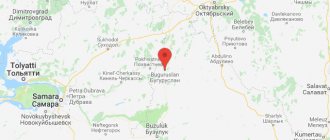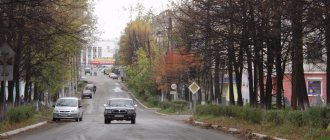- September 11, 2019
- Directions
- Molton
Kursk is one of the largest Russian cities. Where is Kursk? The city is located in the west of the European territory of Russia, 519 km from the Russian capital. This is one of the westernmost cities in the country. Kursk has a long history. It has been mentioned as a city since 1095. Now it is an important scientific, cultural, religious, educational, industrial and transport center.
The area of the city is 208 km2, and the height above sea level is 250 meters. Number of inhabitants: 448,733 people. The mayor of the city is V.N. Karamyshev.
Geography of Kursk
Many people are interested in the question: where is Kursk located, in what region? The city is located on a plain in the west of European Russia. This is the administrative center of the Kursk region. Time zone is Moscow. The climate in the city is largely determined by where Kursk is located. It is temperate continental, with an average January temperature of -6.2 °C, and July of +19.8 °C. This means that winters are relatively mild and summers are neither hot nor cold. The amount of precipitation is significant - 648 mm per year. The maximum occurs in June and July (71 and 78 mm, respectively). In the last decade, summers have become noticeably warmer, and annual temperatures have increased slightly. The amount of precipitation decreased slightly.kur
Story
The first mention of the city in chronicles dates back to 1032; according to some sources, the settlement received city status in 1095. The first mention of the city was noted in the Life of Theodosius of Pechersk, where it is described as a city with developed trade and a large number of local residents.
The first prince of Kursk was the son of Vladimir Monomakh, Izyaslav Vladimirovich. He built a fortress on the site of the modern city, which later became a powerful outpost on the border of Kievan Rus.
In 1238, the fortress city was destroyed by the Tatar-Mongols and in 1285 was attacked by the Nogai horde.
After archaeological research, it was established that the settlement was formed on the site of the current Znamensky Monastery and since 1508 it has been a border town within the Moscow State. Around the same time, the settlement was turned into a fortified city and in 1797 Kursk acquired the status of a provincial city.
In the 15th century, after the raids of the Crimean Tatars and Nogais, the city fell into disrepair. Since the end of the 16th century, after restoration, the city was the most important defensive point of the Russian state.
At different times the city belonged to the provinces:
| Since 1708 | Kyiv province |
| Since 1727 | Belgorod province |
| Since 1779 | Kursk governorship |
| Since 1797 | Kursk province |
In the 18th century, the city of Kursk and its suburbs were divided into settlements:
- Soldatskaya;
- Ochakovskaya;
- Delivery boy;
- Cherkasy;
- Policeman;
- Podiacheskaya;
- Yamskaya;
- Streletskaya;
- Pushkarnaya;
- Kozatskaya.
In the 19th century, the city of Kursk became an important industrial and business center of the country; by the middle of the century there were about 7 dozen plants and factories. There is a comfortable hotel for visitors to the city.
In 1868, Kursk received the status of a railway junction.
Church of the Great Martyr George the Victorious, Course
In 1918, Kursk became the seat of the Provisional Workers' and Peasants' Government of Ukraine.
A people's militia was formed in the city of Kursk. Here 4 regiments were assembled and several destruction battalions were organized. During the German occupation, the city suffered greatly and was liberated by units of the Voronezh Front during the Kharkov offensive operation, which took place on February 2 and 3, 1943.
The city was completely liberated on February 8, and already in July the famous Battle of Kursk or the Battle of Kursk took place near it. During the war, 245 local residents became Heroes of the Soviet Union, 85 people received the title of full Knights of the Order of Glory of the Second World War. After the liberation of Kursk, the restoration of the city began, and some nearby villages were included in its composition.
Universities opened in the city:
- Polytechnic;
- Medical;
- Pedagogical;
- Agricultural.
In 2007, the city was awarded the Order of the Patriotic War, 1st degree, for its courage and valor. Also, the city was awarded the title of “City of Military Glory”.
The Old Russian word “Kursk” was derived from the name of the Kur River, on the banks of which the city was located. The settlement is located on the territory of 2 hills, on the right bank of the Tuskar River, at its confluence with the Kur River. There is a version that the name is possibly related to the ancient word “kurya”, which means a small bay, backwater or narrow river channel.
If you believe the ancient description of the river, in the Middle Ages the Kur was deep and navigable, and only later did it become shallow and turn into a narrow backwater.
Until 2010, the city of Kursk was considered a historical settlement, but in July 2010, by order of the Minister of Culture, the city was deprived of this status.
Urban transport
Public transport in Kursk is quite diverse. There are buses, trolleybuses, trams and even electric buses running around the city. Transport of smaller capacity is represented by minibuses. During the year, urban transport transports up to 200 million people. Kursk trolleybuses have free Internet access.
The vast majority of city routes are bus routes. There are 125 of them. At the same time, there are only 5 tram routes, and 8 trolleybus routes. Gradually, minibuses are being replaced by larger units of transport equipment.
Population
As of February 2022, the number of local residents in the city was approximately 451,000. Taking into account the occupied territory of the settlement, the residential density in the area was 2,364.23 people. per sq. km. The local population in Kursk is called Kuryans, Kuryankas or Kuryanins. Today, in terms of the number of local residents, the city
Kursk ranks 44th out of a possible 1,116 Russian cities. Almost 1 million 100 people live in Kursk and its suburbs, of which 760,000 are urban residents, over 330,000 are located in rural settlements.
Since the beginning of the 21st century, the number of local residents has regularly decreased due to natural decline and the deliberate outflow of people to other areas. The data has changed slightly over the past 2 decades; there has been a slight increase in the population due to the immigration flow of people from the region and neighboring regions.
The only year in which population growth was recorded was 2015. After various programs were implemented at the regional and federal levels, the birth rate in the region increased slightly, while the natural increase in people increased.
The largest number of local residents in Kursk are Russians, their share of the entire population is about 96%. Ukrainians are in second place after Russians, accounting for 1% of the population.
The city is home to small ethnic groups, constituting about 0.3% of the population:
- gypsies;
- Armenians;
- Azerbaijanis;
- Belarusians.
Urban residents in Kursk make up about 65%, rural residents - 35%.
The following ethnic groups live in Kursk (relative to the total number of residents in the region):
| Russians | 98% |
| Belarusians | 75% |
| Bulgarians | 74% |
| Uzbeks | 68% |
| Tatars | 67% |
| Chuvash | 67% |
| Ukrainians | 65% |
The gender ratio of men and women is 45.5% to 54.5%, respectively. For every 1,000 men there are 1,198 women. At the end of the last century, mortality in the region increased and the birth rate situation worsened significantly.
In 2022, there were 4,871 divorces among 7,175 marriages. There were 6.5 marriages and 4.4 divorces per 1,000 inhabitants. A fifth of marriages broke up in the first few years, while in 80% of cases the couple was left with a minor child.
In 2022, 32,000 people came to Kursk for permanent residence, 29,000 people left the city, which implies a migration increase of 3,000. 6,000 people arrived from foreign countries in Kursk, 1,200 people moved from it.
Reviews about Kursk
People are not very active in writing reviews about this city. Many speak negatively about the character of the local residents, considering this the main disadvantage of Kursk. There is also an insufficient number of parks and a reduction in green spaces. They write about salaries that they are low, there is a problem of unemployment, lack of rights for workers. The economic situation is said to be unfavorable. They write that without connections it is difficult to get a decent job, and that life is much better in other cities.
The advantages include good opportunities for growing crops and a large number of retail outlets. They also note that in general this city is no worse than other Russian cities.
Of course, reviews reflect the personal experiences of the authors and do not guarantee that others will necessarily encounter the same problems.
Administrative division
In 1936, the city of Kursk was divided into 3 conditional districts , which are not municipalities, which changed their names on March 1, 1994. Leninsky district became Central, Kirovsky became Zheleznodorozhny, Industrial was renamed Seimsky.
In 1937, by decision of the Presidium of the Kursk Regional Executive Committee, a fourth district was formed, which was called Stalinsky. In 1956, together with the Dzerzhinsky microdistrict, it was united into the Industrial District.
Modernity
After the collapse of the Soviet Union, the severity of the transition period affected all Russian cities. Kursk was no exception either. In the 90s, many enterprises closed here, and there was a high level of unemployment.
In the 2000s, due to the general rise of the Russian economy, life gradually began to improve in this regional center. Industry, production, services and trade began to develop, which means new jobs appeared.
In 2012, the 980th anniversary of the city was solemnly celebrated. Currently, the head of Kursk is Olga Germanova. The city is divided into three districts: Seimsky, Zheleznodorozhny and Central. Today Kursk is a modern Russian regional center.
Composition of the Central Federal District and its capital
The Central Federal District includes 18 subjects of the Russian Federation: seventeen regions and one city of federal subordination - Moscow. The largest metropolis in the country, where, according to official data, more than 12 million people live (about 30% of the total population of the Central Federal District), is the administrative center of the district. This is where the county government is located.
The office of the Presidential Plenipotentiary Representative in the Central Federal District is “registered” in the very center of Moscow (Nikolsky Lane, building 6). The Moscow representative offices of several other districts are located in the same building.
Train Station
Kursk railway station is a junction railway station of the Moscow Railway. Located at Privokzalnaya Square, 1. Belongs to class 1 in terms of volume of work. Station type: local. The number of platforms is 6, the approximate number of tracks is 30. There is free car parking on the territory of the railway station. The opening date of the railway station is 1868. In the railway station building there is a buffet, luggage storage, and a waiting room.
The most popular long-distance train destinations: Belgorod, Moscow, St. Petersburg, Orel, Rzhava, Ponyri, Krivoy Rog, Stary Oskol, Dnepr, Kharkov. Interregional and commuter trains are also serviced at the railway station.
Princely times
Kursk became the center of an appanage principality until 1095, when Vladimir Monomakh, at that time the Prince of Chernigov, and later the Great of Kiev, appointed his son Izyaslav Vladimirovich to reign in this city. But already in 1095, Izyaslav, by order of his father, retired to rule in Murom. In 1096, the prince died in one of the internecine battles. Despite his short reign, Izyaslav managed to build a fortress in Kursk.
The history of the city of Kursk for children is most interesting when it comes to Prince Vsevolod Svyatoslavovich, nicknamed Bui-tur. He is one of the main characters in The Tale of Igor's Campaign. This prince became famous for his incredible strength and courage. Even before his reign, Kursk turned into one of the main fortress borders, designed to protect Rus' from raids by the Polovtsians and other nomads.
In 1180, Vsevolod became Prince of Kursk and Trubetskoy. During his reign, he became famous for his participation in numerous campaigns together with other princes against the Polovtsians. The most famous is the campaign of 1185, sung in the “Tale of Igor’s Campaign,” when he, together with his brother Igor Svyatoslavovich, Prince of Novgorod-Seversky, was captured by the Polovtsians. Vsevolod returned from captivity only in 1188. In 1196 he died.
Taking part in the infamous Battle of Kalka against the Mongols in 1223, the inhabitants of Kursk also sent their garrison to the Russian army. In 1238, during Batu's invasion, the city was destroyed by the Mongol-Tatars. After this, Kursk was rebuilt, but was again devastated in 1285.
In 1362, the Grand Duke of Lithuania Olgerd managed to wrest the city from under Tatar rule and annexed it to his lands.
Note to pilgrims
In the heart of the ancient city there is the Znamensky Cathedral, which is significant for Kursk residents and interesting for guests. The temple was repeatedly destroyed, rebuilt, and even used as a cinema. Today the cathedral has been completely restored, and, like 200 years ago, continues to impress with the splendor of its architecture and the grandeur of its bell tower.
Not far from the main square of Kursk, stands a building atypical for the city - the Roman Catholic Church of the Assumption of the Blessed Virgin Mary. It is made in a neo-Gothic architectural style, curious on the outside, educational on the inside. Coming here, you can listen to organ music or a church service and admire the beautiful view of the city.











